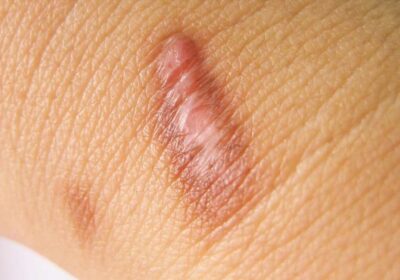Everything You\u2019ve Ever Wanted To Know About Keloid Scars

Scars are often romanticized as proof of our battle wounds and a sign of strength, with plenty of sayings out there to prove it. Sure, time heals all wounds—but sometimes it still leaves behind a scar that doesn’t seem to go away. Dealing with scars, whether it be an acne scar, a hypertrophic scar, or a raised scar, can be a true nuisance.
When it comes to keloid scars, which are a specific type of raised scar that some folks develop as a result of an overly aggressive healing process, it’s not as simple as applying a cream and watching the scar disappear over time. If left untreated by a dermatologist, a keloid scar can get larger and more visible, so it’s important to get treatment earlier, rather than later. And thanks to its texture, it’s not easily covered up with concealer, making it even more crucial to treat it as soon as possible.
Keloids are most likely to appear on those with darker skin tones, and they normally form gradually over time. They frequently develop on areas of the body including the ears, neck, shoulders, chest, and back. Below, we’ve asked the experts exactly what they are, what can cause a keloid, and their insight on how to treat keloids.
What is a keloid?
A keloid is a scar that has healed with excess collagen leading to a raised appearance. “It is larger and wider than the original skin injury or wound, and keeps forming after the wound is healed,” explains Anna Karp, MD, a board-certified dermatologist in New York City.
Essentially, keloid scars are benign tumors of scar tissue. “They usually do not spread to other parts of the body, but they do grow locally, and they usually have a strong genetic component,” explains Paul Jarrod Frank, MD, a celebrity cosmetic dermatologist in New York City. “Any type of wound can cause a keloid scar—piercings, tattoos, a pimple, or any type of surgery either essential or cosmetic. Because of this, people susceptible to keloid scars should avoid elective surgeries, if necessary.”
What are the symptoms of a keloid?
A keloid is usually diagnosed visually, but it may be itchy or painful while the skin is healing. “It will look like a raised scar with a flat or round (when on the earlobe) hairless surface that is usually darker than your own skin,” explains Dr. Karp.
Although most folks complain of mild discomfort and itching when developing keloids, these raised scars can actually be painful if they develop on the chest area.
What can cause a keloid?
Keloids can form after an injury to the skin, whether it be an accidental injury or a surgery—keloids generally form after the skin has been punctured. Additionally, some folks are prone to keloids when serious acne clears.
“There are those that suffer from spontaneous keloids, which has a genetic component to it and generally affects the chest—genetic factors definitely play a role,” explains Dr. Frank. “If someone in your family suffers from keloids, the odds are higher that you can develop them as well.” Those of African, Asian, and Hispanic descent are more prone and keloids generally affect those between the ages of 10 to 30 years old.
A cut, surgery, burn, or severe acne can cause a keloid to form, and certain areas of the body, like the earlobes, chest, and shoulders are more prone to keloids. “If you already had one keloid, the chance of developing another one is higher,” says Dr. Karp.
How are keloids diagnosed?
Keloids are generally diagnosed by your dermatologist who is able to evaluate and determine if it is, in fact, a keloid based on its appearance, history, and location. “People often confuse keloids with hypertrophic scars, and a proper evaluation by a board-certified dermatologist will clear up any confusion,” says Dr. Frank.
If a keloid looks unusual, your dermatologist will perform a simple skin biopsy to have it further assessed.
How should you treat a keloid?
There is no known cure for keloids, but if you already have one, the best treatment is to get an intralesional steroid injection into the area by a dermatologist. “This will flatten the keloid and may take a few treatments for optimal results,” says Dr. Karp. “I often combine injections with freezing, known as cryotherapy.” Sometimes, the skin is red or dark brown after the keloid has flattened, and using a laser is a good way to address that.
Sometimes, large keloids have to be removed surgically. “Afterward, preventative steroid injections, as well as putting pressure on the area to reduce blood flow, can stop a keloid from returning,” explains Dr. Karp. “Compression garments or specialized pressure earrings can help.”
Dr. Frank tries to avoid cutting keloids out at all costs, since cutting the scar will increase the chances of it coming back and forming another keloid. “In my office, our treatment [for keloids] is usually a combination of injectable agents like cortisone or Kenalog, and the other agent we use is a chemotherapeutic agent called Five Fu (Five Fluorouracil),” he says. “I often combine this with VBeam or Pulsed Dye Laser Therapy, which is often done at the same time as the injections. What this does is strangulates the scar of its blood supply that is causing it to be red and make it thick. On a non-medicinal scale, people use silicone sheeting to put pressure on it to help.”
How can you prevent a keloid from forming?
Early treatment is key to preventing a keloid from forming. “I like to use silicone scar gels or patches to optimize healing of any skin lesion,” Dr. Karp says. “Moisturizing your skin with an antioxidant-rich product like Bio-Oil also helps in prevention, and sunscreen prevents the lesion from darkening.” If you know you are prone to keloids, Dr. Karp suggests avoiding getting tattoos or piercings.
Source: Read Full Article



